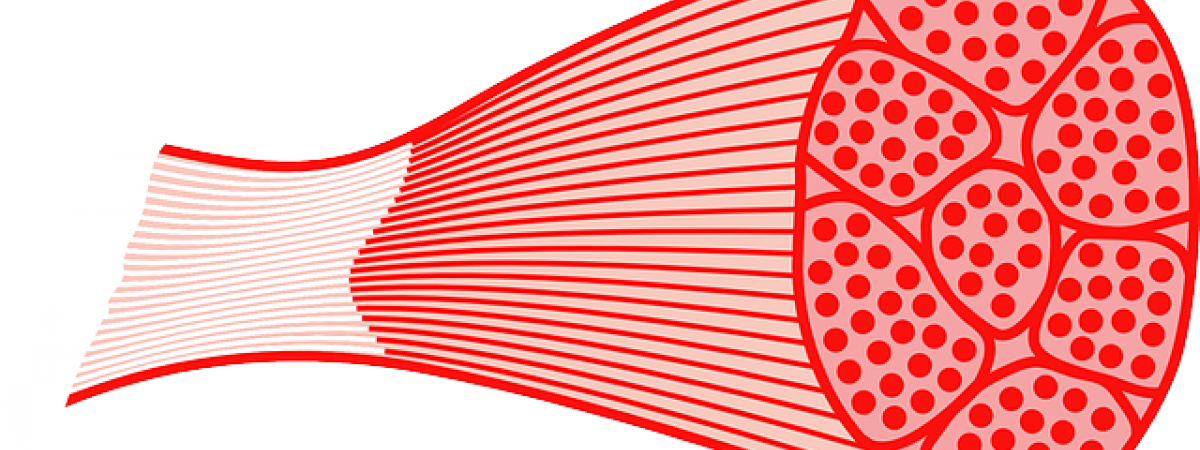How can we beat muscular dystrophy?

Your body contains nearly 700 individual muscles anchored to your skeleton, allowing you to move. Equally important are those muscles not attached to your skeleton, such as those of the heart, intestine and blood vessels.Helen Cowan interviews Professor of Neuroscience, Matthew Wood, from Oxford University, about his work on muscles and muscular dystrophy.
The types of muscle
“The most abundant type of muscle in your body is skeletal muscle, making up about 40% of your body mass. It’s found throughout your body, for example in the arms, legs, trunk, skull and eyes. You have control over this type of muscle, and can decide whether to make it move.
Cardiac muscle, as its name suggests, is only found in the heart. You have no control over your heart muscle: it contracts automatically. It is the only type of muscle that works relentlessly, 24 hours a day, 365 days of the year to maintain life.
Smooth muscle is found in the gut, the lungs, and around blood vessels to control blood supply.”
How are muscles affected in Muscular Dystrophy?
“All muscles are affected by muscular dystrophy, because the gene which is defective or damaged in this disease is found in all forms of muscle. The degree to which the disease impacts the function of different muscle types does, however, vary.
All muscles are affected by muscular dystrophy, because the gene which is defective or damaged in this disease is found in all forms of muscle.
Skeletal muscles, and particularly those of the arms, legs, hips and shoulders are often affected earliest and to the greatest degree; muscles of breathing may also become weaker.
The heart muscle of all patients with Duchenne Muscular Dystrophy (the most severe form of Muscular Dystrophy) is also weakened: a fact that was only discovered relatively recently. From the age of seven or eight patients therefore now receive medication to strengthen their heart.
Smooth muscle is affected to a lesser extent; constipation may result.”
What are the different types of Muscular Dystrophy?
“The classical type is that which we call Duchenne Muscular Dystrophy, first described by the French neurologist Duchenne in the 1860s. It usually affects only boys and is caused by an abnormality in the gene which makes a very big protein called Dystrophin. It’s found in all muscle types and works to maintain the structure or architecture of muscle cells as they contract.
In Duchenne Muscular Dystrophy, the absence of Dystrophin means that muscles are unable to maintain their structure and architecture as they contract, and so they get progressively weaker (over 20-30 years).
Becker’s Muscular Dystrophy is another form of the disease: some dystrophin remains so the symptoms are milder.
Other types of Muscular Dystrophy can affect boys and girls: in these types, smaller, less important proteins (which work together with Dystrophin) are abnormal; fewer muscles are likely to be involved, and less severely. ”
What treatments are being investigated for Muscular Dystrophy?
“We need to find ways to compensate for the loss of Dystrophin. Drugs are being designed that might deliver a new copy of the Dystrophin gene to the muscles (though it’s the biggest gene in the human body and so this is proving difficult), or cause other similar muscle proteins to be made more abundantly to compensate for the absence of Dystrophin (this concept began in Oxford and continues today).
My team is looking at an injection that could repair the faulty Dystrophin gene so that it makes functional Dystrophin in the muscles. One such drug is called eteplirsen: in 2016 it became the first ever genetic drug approved for treating Muscular Dystrophy.”
One such drug is called eteplirsen: in 2016 it became the first ever genetic drug approved for treating Muscular Dystrophy.
The future is brighter (and orange)
“It’s difficult to get the drugs to reach all the muscles around the body: eteplirsen gives some benefit to patients, but not enough. We therefore continue to look for more effective drugs, and it’s very likely that in the next 5 to 10 years, there will be an even better drug available to improve the quality of life of these patients, and also extend their life.”
It’s an exciting time in the treatment of this disease. Oxford University have just partnered with Muscular Dystrophy UK to create a ‘Neuromuscular Research Centre’ to continue this research. If you would like to support this work, why not don a trademark stand-out-from-the-crowd orange Muscular Dystrophy UK T-shirt and take part in their Town and Gown 10k Run? Exercise your muscles whilst helping fund vital muscle research.
